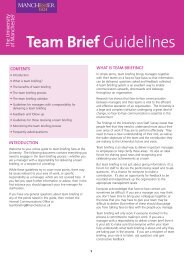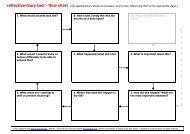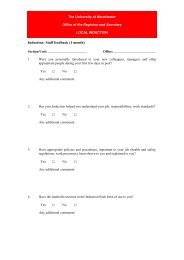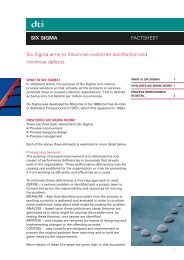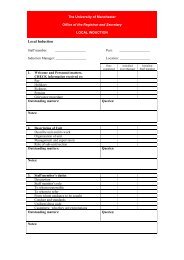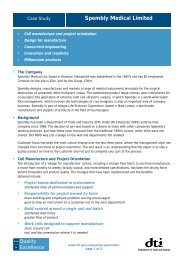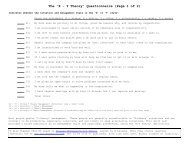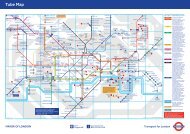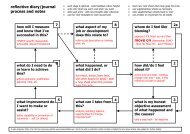team-building jigsaw puzzle game template - Businessballs
team-building jigsaw puzzle game template - Businessballs
team-building jigsaw puzzle game template - Businessballs
- No tags were found...
You also want an ePaper? Increase the reach of your titles
YUMPU automatically turns print PDFs into web optimized ePapers that Google loves.
<strong>team</strong>-<strong>building</strong> <strong>jigsaw</strong> <strong>puzzle</strong> <strong>game</strong> <strong>template</strong><br />
© Alan Chapman 2006. A free resource from www.businessballs.com. Not to be sold or published.<br />
Alan Chapman accepts no liabilities. See the instructions attached, or at the <strong>Businessballs</strong> website -<br />
search keywords 'businessballs <strong>jigsaw</strong> <strong>puzzle</strong> exercise'.
usinessballs <strong>jigsaw</strong> <strong>puzzle</strong> <strong>game</strong>/<strong>team</strong> <strong>puzzle</strong> race exercise (for <strong>team</strong>-<strong>building</strong>, illustrating<br />
<strong>team</strong>work, <strong>team</strong> problem-solving, lateral thinking, etc)<br />
For groups of 8-100 people, even more with suitable adaptation - this is a very adaptable <strong>game</strong>. Divide<br />
the group into a number of <strong>team</strong>s. Give each <strong>team</strong> some pieces of a <strong>jigsaw</strong> <strong>puzzle</strong> and instruct them to<br />
assemble the <strong>puzzle</strong> as quickly as possible. Ensure each <strong>team</strong>'s pieces appear initially as though they<br />
could be an entire <strong>puzzle</strong> in their own right.<br />
Say, "The task of each <strong>team</strong> is to assemble the <strong>puzzle</strong> as quickly as possible. Each <strong>team</strong> has the same<br />
<strong>puzzle</strong>. No further instructions will be given," (other than options explained below; the point is for <strong>team</strong>s<br />
to resolve the exercise for themselves working together in <strong>team</strong>s, not by asking the facilitator).<br />
The <strong>team</strong>s will assume they are competing against each other, but in fact there is only one <strong>jigsaw</strong> <strong>puzzle</strong>,<br />
and the pieces are shared out among the <strong>team</strong>s. If the <strong>team</strong>s are in the same room they soon find out,<br />
and begin to cooperate. If they are in different rooms the realisation takes a little longer, but eventually<br />
the <strong>team</strong>s understand that the pieces are held by all the <strong>team</strong>s and the only way to do the <strong>puzzle</strong> is to<br />
work together.<br />
The facilitator's preparation for this exercise is therefore to obtain or create a <strong>jigsaw</strong> <strong>puzzle</strong> whose<br />
complexity and number of pieces are appropriate for the group numbers and time available for the<br />
activity. Ensure there are sufficient pieces to occupy the total number of <strong>team</strong> members, and obviously<br />
each <strong>team</strong> needs a suitably sizes table or floorspace to work on, so that all <strong>team</strong> members can be<br />
involved. Larger <strong>team</strong>s (upwards of five people) will be additionally challenged in areas of <strong>team</strong><br />
organisation and 'work allocation' to ensure everyone is involved.<br />
The exercise can be made easier and quicker for the <strong>team</strong>s by describing or giving clues as to the shape<br />
of the <strong>puzzle</strong>, , for example, (if using the <strong>template</strong> here), "It's a square," or "It's a geometric shape," etc.<br />
Offering a prize in the event that the <strong>puzzle</strong> is completed within a timescale of say 10 minutes (or during<br />
the session, day, whatever, depending on the situation), adds extra interest. The prize is obviously given<br />
to the whole group, so be mindful of the budget... Use these words or similar: "In the event that the<br />
<strong>puzzle</strong> is completed (within...) a prize will be awarded," rather than referring to 'the winning <strong>team</strong>," which<br />
is not technically correct, because the activity is one of cooperation not competition.<br />
Exercises based on this theme demonstrate that all the people and all the <strong>team</strong>s make up the whole, and<br />
no <strong>team</strong> or individual can do it alone.<br />
Ideally you need to have a space somewhere that the <strong>puzzle</strong> can be kept and worked on during teabreaks,<br />
should the activity over-run the initial time-slot. This is not a problem - people will continue to<br />
work on it during the day/session, and the ongoing activity and assembled <strong>puzzle</strong> serve as a constant<br />
reminder to <strong>team</strong> members of the theme of cooperation and <strong>team</strong>work, so don't worry (and explain this<br />
to the group once they've started cooperating) if the <strong>puzzle</strong> is not completed in the time initially allotted.<br />
Here is a <strong>jigsaw</strong> <strong>puzzle</strong> pattern is for groups of, say, up to twenty people, split into five <strong>team</strong>s of four.<br />
The <strong>puzzle</strong> needs to be significantly enlarged - at least five to ten times bigger - for best effect, so that it's<br />
visible and usable for lots of people, and makes a big impact. The more <strong>team</strong>s and players, the bigger the<br />
enlargement is required (and the more pieces - achieved by drawing and cutting more lines). The <strong>jigsaw</strong><br />
pattern artwork needs to be taken to a decent print/copy bureau, enlarged, printed, laminated onto<br />
card or foam and cut by hand. If you possess basic craft skills and the necessary equipment you can do it<br />
yourself - it's quite straightforward really.<br />
The dashed lines are thick so as to be cut through the centre (along the lines), which helps the <strong>puzzle</strong><br />
assembly. You can adapt the <strong>puzzle</strong> for more players by drawing more drawing more lines to increase the<br />
number of pieces. The design of the <strong>puzzle</strong> is currently the businessballs logo although you can substitute<br />
it with your own (if using the MSWord version, via box 'fill' pattern). Someone who knows MSWord well<br />
will know how to adapt/develop it. Use and adapt the <strong>puzzle</strong> artwork, or source your own <strong>jigsaw</strong> <strong>puzzle</strong>,<br />
to suit your own situation.<br />
© Alan Chapman 2006. A free resource from www.businessballs.com. Not to be sold or published. Alan Chapman accepts no<br />
liabilities. See the <strong>template</strong> on page 1, or at the <strong>Businessballs</strong> website - search keywords 'businessballs <strong>jigsaw</strong> <strong>puzzle</strong> exercise'.



